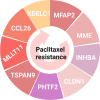Key genes and molecular mechanisms related to Paclitaxel Resistance
- PMID: 39003454
- PMCID: PMC11245874
- DOI: 10.1186/s12935-024-03415-0
Key genes and molecular mechanisms related to Paclitaxel Resistance
Abstract
Paclitaxel is commonly used to treat breast, ovarian, lung, esophageal, gastric, pancreatic cancer, and neck cancer cells. Cancer recurrence is observed in patients treated with paclitaxel due to paclitaxel resistance emergence. Resistant mechanisms are observed in cancer cells treated with paclitaxel, docetaxel, and cabazitaxel including changes in the target molecule β-tubulin of mitosis, molecular mechanisms that activate efflux drug out of the cells, and alterations in regulatory proteins of apoptosis. This review discusses new molecular mechanisms of taxane resistance, such as overexpression of genes like the multidrug resistance genes and EDIL3, ABCB1, MRP1, and TRAG-3/CSAG2 genes. Moreover, significant lncRNAs are detected in paclitaxel resistance, such as lncRNA H19 and cross-resistance between taxanes. This review contributed to discovering new treatment strategies for taxane resistance and increasing the responsiveness of cancer cells toward chemotherapeutic drugs.
Keywords: ABCB1; Paclitaxel; Resistance; TRAG-3/CSAG2 gene.
© 2024. The Author(s).
Conflict of interest statement
The author declares no competing interests.
Figures







References
-
- Ferlay J, Ervik M, Lam F, Colombet M, Mery L, Piñeros M, Znaor A, Soerjomataram I, Bray F. Observatory:Cancer Today. Lyon Int Agency Res Cancer 2020.
-
- Asić K. Dominant mechanisms of primary resistance differ from dominant mechanisms of secondary resistance to targeted therapies. Crit Rev Oncol Hematol. 2016;97:178–96. - PubMed
-
- Alkafaas SS, Obeid OK, Radwan MA, Elsalahaty MI, ElKaffas SS, Hafez W, Janković N, Hessien M. Novel insight into mitochondrial dynamin-related protein-1 as a new chemo-sensitizing target in resistant cancer cells. Bioorg Chem. 2024;150:107574. - PubMed
-
- Diab T, Alkafaas SS, Shalaby TI, Hessien M. Paclitaxel nanoparticles induce apoptosis and regulate txr1, cyp3a4 and cyp2c8 in breast cancer and hepatoma cells. Anti-Cancer Agents Med Chem (Formerly Curr Med Chemistry-Anti-Cancer Agents) 2020;20(13):1582–91. - PubMed
Publication types
LinkOut - more resources
Full Text Sources

